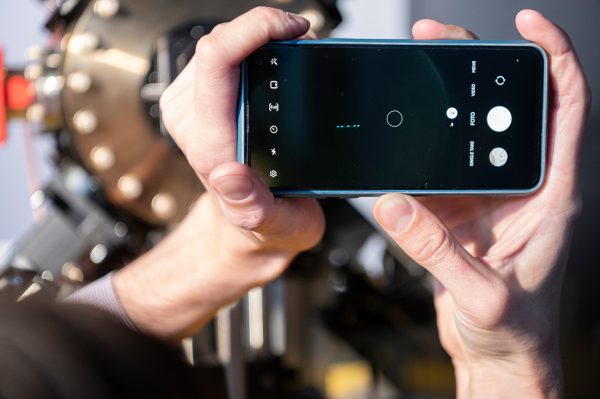Do words like quantum optics and ions make your head spin? Did you shy away from studying sciences in school because you didn’t think you were smart enough? Physicist and TRU alum Dr. Natascha Hedrich has dedicated her career to making highly technical information accessible (and interesting) for the masses.
“There is so much cool research being done at the moment and being able to share it with people is really neat,” says Hedrich, who recently started a position at focusTerra, an earth and science discovery centre in Zürich, Switzerland. She enjoys working on ways to make science approachable and give ordinary people an opportunity to see amazing phenomena.
Hedrich grew up in Pritchard and received a Bachelor of Science in math and physics from TRU before relocating to Switzerland, where she completed her Master of Science in physics (quantum optics) at ETH Zürich followed by a doctor of philosophy in physics at the University of Basel.
A self-described “sci-fi nerd” from an early age, Hedrich credits her supportive parents and past teachers with encouraging her love of math and science.
“I’ve always really enjoyed science. I also had really fantastic math and physics teachers, so that played a big role in deciding what to study,” she says, adding that she chose to start her university journey at TRU so she could remain close to home.
Hedrich says in spite of being one of the only women pursuing a physics degree at the time, she never felt excluded and enjoyed being part of a close-knit department. “I had a great group of fellow students and we did a lot of things together. Being such a small group, we created strong bonds — not just the students but also with the professors — those relationships were very beneficial.”
TRU education inspires desire for more
After completing her bachelor’s degree, Hedrich wanted to explore physics further. She considered studying theoretical physics, but eventually opted to pursue experimental physics. She applied to several graduate schools before choosing ETH Zürich, a school known for its high academic standards. Switzerland was a big move, but luckily Hedrich grew up in a German-speaking household, so she didn’t have a language barrier to add to the culture shock. She describes the experience as challenging but gratifying.
As she finished up her doctorate in Basel, she decided it was time to get out of the lab and explore a more public role in science education. She supervised the development of a new exhibit at the Swiss Science Centre Technorama that allows people to view single-charged atoms, which are called ions. Throughout the development of the project, Hedrich helped bridge the gap between the scientists creating these ion traps and the people working at the centre who endeavoured to bring the phenomenon to a wider audience.

Natascha Hedrich worked on a museum exhibit in Switzerland that shows charged atoms without a microscope.
“Using a device known as an ion trap, scientists can hold single charged atoms (ions) in place. If you shine a laser at these ions, they give off light, which you can see by eye. The tiny points of light you see are actually single atoms. This is a very rare thing that usually only physicists in the lab get to see. My job was to work with them to design an exhibit that would make it a little more understandable to give more people the opportunity to see this amazing phenomenon,” she says.
“Atoms are the building blocks of the universe. All matter — stars, planets, plants and us — are made up of an unimaginably large number of atoms. Even though they are everywhere, outside of a physics lab, they are invisible to the naked eye, and unbelievably small. So by seeing atoms, we are seeing some of the most fundamental building blocks of life. The fact that we can hold in place, manipulate and see single atoms is an incredible achievement that has led to three Nobel prizes for various aspects of the technology.”
Once the exhibit was running smoothly, it was time for Hedrich to explore her next professional opportunity. She hoped to find a position where she could continue to bring her passion for science to the public using both her communication skills and scientific background. When she met the team at focusTerra, she felt she’d found the right place.
Exciting opportunity
“It’s sort of my job to make sure that everything continues running smoothly,” she says. Since she started there in early March, she has been extremely busy getting to know the team and learning how all the museum operates. “There are a wide variety of tasks, from crawling behind a wall to figure out why something isn’t working to brainstorming ideas for future exhibits.”
Currently one of the highlights at focusTerra is the earthquake simulator that can imitate the ground motion of earthquakes. According to the website, the sim’s purpose is to increase public awareness of Switzerland’s vulnerability to earthquakes and also to teach safety in the case of experiencing a real earthquake.
“School kids and the general public can have the experience of being in an earthquake without the fear and worry of actually being in one,” says Hedrich.
While her position is a new and evolving, she looks forward to settling into her role and using her skills to further develop the museum. She’s a huge proponent of doing what you love and not letting anything hold you back — including the fear of not being the best or the brightest.
“It’s not about having the best grades or being the most intelligent person — it’s just a lot of hard work and dedication,” she says. “Being smart will get you to a certain point, but it’s a lot more valuable to be interested and motivated.”

